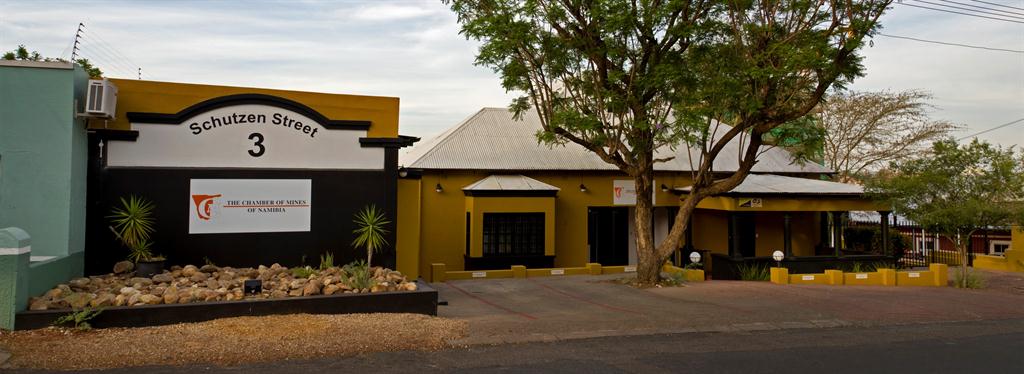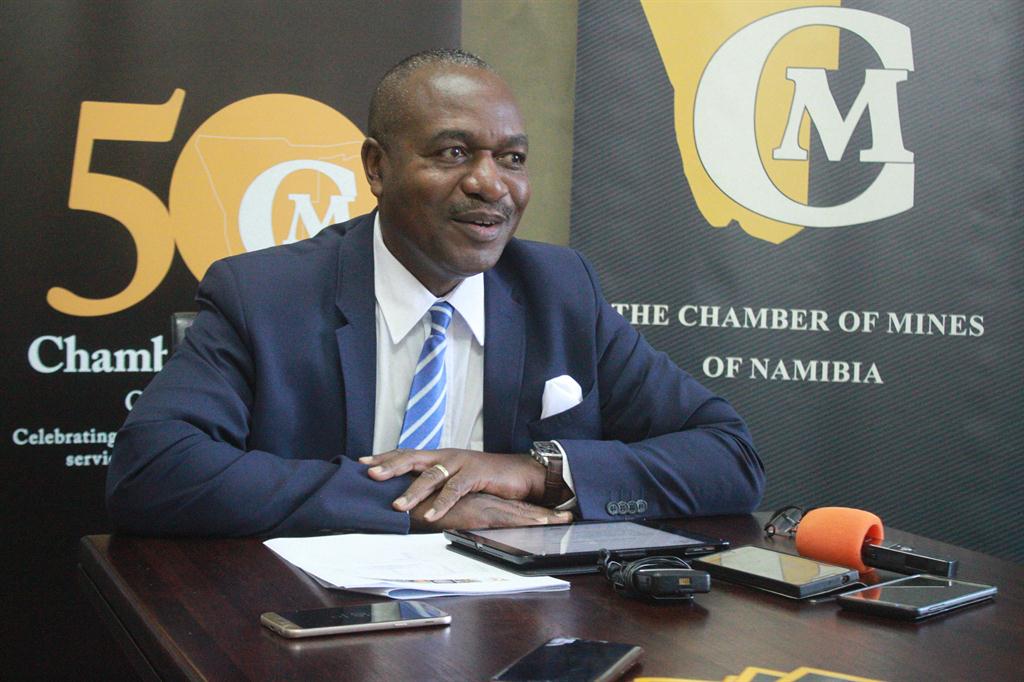50 years of the Chamber of Mines
The Namibian mining industry organisation is making strides towards African integration.
AUGETTO GRAIG
On Thursday, 9 May 2019 the Chamber of Mines of Namibia will celebrate its 50th anniversary. This year marks the golden jubilee of an organisation that has been instrumental in promoting economic resilience and success in the country.
In 2018 the mining industry was the best-performing sector of the local economy. Fifty years of excellence and dedication have resulted in an adaptive, inclusive and progressive mining industry.
It was on a Friday in 1969 that the inaugural meeting of 19 mining and exploration companies took place at the Grand Hotel in Windhoek. There the Association of Mining Companies of South West Africa was born, complete with a constitution and rules of association. After a secret ballot six companies were elected to the association’s council.
The first president of the association, the late Jim Ratledge of the Tsumeb Corporation, was assisted by Des Mathews as both secretary and treasurer. Mathews, along with Jorn Berning and the first minister of mines after independence, Andimba Toivo ya Toivo, were later recognised as honorary life members of the chamber. In the early years, only four of the 19 companies present at the meeting were active.
Today more than 100 companies are listed as active members in different categories. The legendary Steve Galloway is currently listed as the honorary life member of the chamber.
The first full-time secretary was Bill Bailie, appointed in February 1979. The next month, a revised constitution was adopted at a special meeting of the association, which transformed the association into the Chamber of Mines of South West Africa/Namibia.
The transformation was completed at a council meeting in January 1990 when the name was officially changed to the Chamber of Mines of Namibia. The chamber’s council acts as its board of directors, while committees have been formed to deal with relevant issues in areas of special interest.
Because of the importance placed on the safety of mine workers, a labour committee and safety committee have been established. Members of the safety committee have, for instance, been involved in drafting new mine health and safety regulations, and also run the regular inter-mine safety competition. Other committees include the labour committee, the environmental committee and the prospecting committee.
Although the Chamber of Mines of Namibia concentrates on local miners, it supports moves towards regional development and became a founding member of the SADC chamber of mines initiative known as MIASA (Mining Industry Associations of Southern Africa).
Local chamber CEO Veston Malango was present at the launch of the Association of Chambers of Mines and other Mining Associations (ACMMAA) in Johannesburg in October last year. He served as technical advisor to the interim committee tasked with drafting the constitution, and was also elected to serve on the executive to run the organisation for the first two years.
According to Malango the Namibian mining chamber has made an immense contribution to the Namibian economy over the past five decades.
“The industry fully supported the young republic after independence in 1990 and remains dedicated to promoting Namibia as the prime mining destination in Africa,” he said at the recent announcement of the upcoming mining expo in May.
He emphasised the value of close cooperation with and support from the government to successful mining in Namibia.
“We have always strived to reconcile the interests of miners, workers and the economy at large though an open dialogue with our Namibian leaders,” he said.
This has earned the Namibian chamber recognition in Africa, he said. The local chamber is often approached for advice by counterparts in other African countries when tensions mount between governments and mining companies.
“We have demonstrated that we are not just fair-weather friends. The industry continues to contribute to Namibia’s socio-economic growth, even in challenging times, while the Chamber of Mines plays an active role in shaping a healthy regulatory and policy environment, and through its committees serves as a strong peer-review mechanism for the industry on issues of health and safety, environment, human resources and sustainability,” he said.
Highlighting the performance of mining in Namibia last year, Malango noted the strong growth rate of 22%.
“According to these statistics the positive industry growth was driven by production increases of diamonds, and particularly uranium, in comparison with 2017,” he said.
The Chamber of Mines of Namibia will present its own full report on industry performance at its annual general meeting scheduled for 7 May 2019 at the Windhoek Country Club.
According to Malango the rebirth of some of Namibia’s older mines is symbolic of resurgence in the industry. AfriTin reopening the Uis tin mine and North River Resources getting the old Namib Lead and Zinc mine running again, both scheduled to enter production this year, tell of the rich history and the promising future of mining in Namibia.
On the other hand, some mines are approaching the end of their life-of-mine expectations. That emphasises the need for sustainability through the establishment of new mines.
“It is imperative that Namibia attracts investment into exploration as this will increase the likelihood of new discoveries and the development of new mines,” Malango said.
Last year’s decision by the minister of mines and energy, Tom Alweendo, to remove additional conditions for the granting of exploration licences is expected to boost investment in exploration.
“The chamber recognises this as one of its many achievements in the policy space and remains committed to ensuring a favourable policy environment for another fifty years to come,” Malango said.
“I look forward to celebrating 50 years of excellence with you all at the Mining Expo and Conference.”
On Thursday, 9 May 2019 the Chamber of Mines of Namibia will celebrate its 50th anniversary. This year marks the golden jubilee of an organisation that has been instrumental in promoting economic resilience and success in the country.
In 2018 the mining industry was the best-performing sector of the local economy. Fifty years of excellence and dedication have resulted in an adaptive, inclusive and progressive mining industry.
It was on a Friday in 1969 that the inaugural meeting of 19 mining and exploration companies took place at the Grand Hotel in Windhoek. There the Association of Mining Companies of South West Africa was born, complete with a constitution and rules of association. After a secret ballot six companies were elected to the association’s council.
The first president of the association, the late Jim Ratledge of the Tsumeb Corporation, was assisted by Des Mathews as both secretary and treasurer. Mathews, along with Jorn Berning and the first minister of mines after independence, Andimba Toivo ya Toivo, were later recognised as honorary life members of the chamber. In the early years, only four of the 19 companies present at the meeting were active.
Today more than 100 companies are listed as active members in different categories. The legendary Steve Galloway is currently listed as the honorary life member of the chamber.
The first full-time secretary was Bill Bailie, appointed in February 1979. The next month, a revised constitution was adopted at a special meeting of the association, which transformed the association into the Chamber of Mines of South West Africa/Namibia.
The transformation was completed at a council meeting in January 1990 when the name was officially changed to the Chamber of Mines of Namibia. The chamber’s council acts as its board of directors, while committees have been formed to deal with relevant issues in areas of special interest.
Because of the importance placed on the safety of mine workers, a labour committee and safety committee have been established. Members of the safety committee have, for instance, been involved in drafting new mine health and safety regulations, and also run the regular inter-mine safety competition. Other committees include the labour committee, the environmental committee and the prospecting committee.
Although the Chamber of Mines of Namibia concentrates on local miners, it supports moves towards regional development and became a founding member of the SADC chamber of mines initiative known as MIASA (Mining Industry Associations of Southern Africa).
Local chamber CEO Veston Malango was present at the launch of the Association of Chambers of Mines and other Mining Associations (ACMMAA) in Johannesburg in October last year. He served as technical advisor to the interim committee tasked with drafting the constitution, and was also elected to serve on the executive to run the organisation for the first two years.
According to Malango the Namibian mining chamber has made an immense contribution to the Namibian economy over the past five decades.
“The industry fully supported the young republic after independence in 1990 and remains dedicated to promoting Namibia as the prime mining destination in Africa,” he said at the recent announcement of the upcoming mining expo in May.
He emphasised the value of close cooperation with and support from the government to successful mining in Namibia.
“We have always strived to reconcile the interests of miners, workers and the economy at large though an open dialogue with our Namibian leaders,” he said.
This has earned the Namibian chamber recognition in Africa, he said. The local chamber is often approached for advice by counterparts in other African countries when tensions mount between governments and mining companies.
“We have demonstrated that we are not just fair-weather friends. The industry continues to contribute to Namibia’s socio-economic growth, even in challenging times, while the Chamber of Mines plays an active role in shaping a healthy regulatory and policy environment, and through its committees serves as a strong peer-review mechanism for the industry on issues of health and safety, environment, human resources and sustainability,” he said.
Highlighting the performance of mining in Namibia last year, Malango noted the strong growth rate of 22%.
“According to these statistics the positive industry growth was driven by production increases of diamonds, and particularly uranium, in comparison with 2017,” he said.
The Chamber of Mines of Namibia will present its own full report on industry performance at its annual general meeting scheduled for 7 May 2019 at the Windhoek Country Club.
According to Malango the rebirth of some of Namibia’s older mines is symbolic of resurgence in the industry. AfriTin reopening the Uis tin mine and North River Resources getting the old Namib Lead and Zinc mine running again, both scheduled to enter production this year, tell of the rich history and the promising future of mining in Namibia.
On the other hand, some mines are approaching the end of their life-of-mine expectations. That emphasises the need for sustainability through the establishment of new mines.
“It is imperative that Namibia attracts investment into exploration as this will increase the likelihood of new discoveries and the development of new mines,” Malango said.
Last year’s decision by the minister of mines and energy, Tom Alweendo, to remove additional conditions for the granting of exploration licences is expected to boost investment in exploration.
“The chamber recognises this as one of its many achievements in the policy space and remains committed to ensuring a favourable policy environment for another fifty years to come,” Malango said.
“I look forward to celebrating 50 years of excellence with you all at the Mining Expo and Conference.”





Kommentaar
Republikein
Geen kommentaar is op hierdie artikel gelaat nie